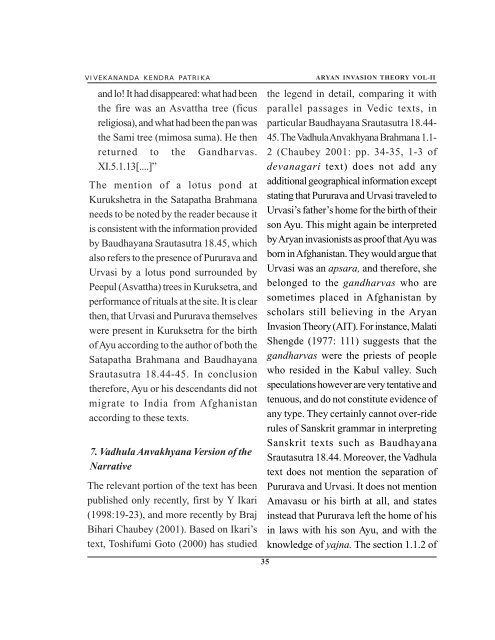Aryan Invasion Theory - Publication - Vivekananda Kendra
Aryan Invasion Theory - Publication - Vivekananda Kendra
Aryan Invasion Theory - Publication - Vivekananda Kendra
You also want an ePaper? Increase the reach of your titles
YUMPU automatically turns print PDFs into web optimized ePapers that Google loves.
VIVEKANANDA KENDRA PATRIKA ARYAN INVASION THEORY VOL-II<br />
and lo! It had disappeared: what had been<br />
the fire was an Asvattha tree (ficus<br />
religiosa), and what had been the pan was<br />
the Sami tree (mimosa suma). He then<br />
returned to the Gandharvas.<br />
XI.5.1.13[....]”<br />
The mention of a lotus pond at<br />
Kurukshetra in the Satapatha Brahmana<br />
needs to be noted by the reader because it<br />
is consistent with the information provided<br />
by Baudhayana Srautasutra 18.45, which<br />
also refers to the presence of Pururava and<br />
Urvasi by a lotus pond surrounded by<br />
Peepul (Asvattha) trees in Kuruksetra, and<br />
performance of rituals at the site. It is clear<br />
then, that Urvasi and Pururava themselves<br />
were present in Kuruksetra for the birth<br />
of Ayu according to the author of both the<br />
Satapatha Brahmana and Baudhayana<br />
Srautasutra 18.44-45. In conclusion<br />
therefore, Ayu or his descendants did not<br />
migrate to India from Afghanistan<br />
according to these texts.<br />
7. Vadhula Anvakhyana Version of the<br />
Narrative<br />
The relevant portion of the text has been<br />
published only recently, first by Y Ikari<br />
(1998:19-23), and more recently by Braj<br />
Bihari Chaubey (2001). Based on Ikari’s<br />
text, Toshifumi Goto (2000) has studied<br />
35<br />
the legend in detail, comparing it with<br />
parallel passages in Vedic texts, in<br />
particular Baudhayana Srautasutra 18.44-<br />
45. The Vadhula Anvakhyana Brahmana 1.1-<br />
2 (Chaubey 2001: pp. 34-35, 1-3 of<br />
devanagari text) does not add any<br />
additional geographical information except<br />
stating that Pururava and Urvasi traveled to<br />
Urvasi’s father’s home for the birth of their<br />
son Ayu. This might again be interpreted<br />
by <strong>Aryan</strong> invasionists as proof that Ayu was<br />
born in Afghanistan. They would argue that<br />
Urvasi was an apsara, and therefore, she<br />
belonged to the gandharvas who are<br />
sometimes placed in Afghanistan by<br />
scholars still believing in the <strong>Aryan</strong><br />
<strong>Invasion</strong> <strong>Theory</strong> (AIT). For instance, Malati<br />
Shengde (1977: 111) suggests that the<br />
gandharvas were the priests of people<br />
who resided in the Kabul valley. Such<br />
speculations however are very tentative and<br />
tenuous, and do not constitute evidence of<br />
any type. They certainly cannot over-ride<br />
rules of Sanskrit grammar in interpreting<br />
Sanskrit texts such as Baudhayana<br />
Srautasutra 18.44. Moreover, the Vadhula<br />
text does not mention the separation of<br />
Pururava and Urvasi. It does not mention<br />
Amavasu or his birth at all, and states<br />
instead that Pururava left the home of his<br />
in laws with his son Ayu, and with the<br />
knowledge of yajna. The section 1.1.2 of

















